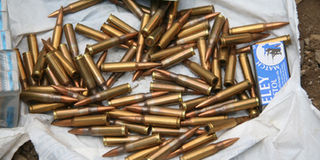Police probed over Narok arms cache

Some of the 31,000 bullets seized in the Narok operation on Monday. Photo/STEPHEN MUDIARI
Detectives are investigating officers from both the regular and Administration Police to unearth how bullets found in Narok disappeared from a factory in Eldoret.
The Kenya Ordinance Factory products are only sold to security forces and authorised external markets yet 130,000 bullets from the factory found their way into an individual’s hands.
“A number of our officers have recorded statements… but this does not mean they are guilty,” Police Commissioner Mathew Iteere said at a news conference in Nairobi on Wednesday. “We wish to inform the public that our detectives are investigating the case comprehensively,” he added.
When pressed further for details, Mr Iteere said the matter was still before the courts and he did not want to jeopardise investigations. The ammunition is suspected to be part of contraband goods constantly smuggled into the neighbouring country by businessmen.
However, because of the illegal nature of the consignment, police believe some of the ammunition might have found its way into local criminal hands. On Wednesday, the Department of Defence (DoD) denied that the ammunition had directly been smuggled from the high-security bullet factory in Eldoret.
Instead, DoD pointed accusing fingers at their clients who include the Kenya Police, Administration Police and the Kenya Armed Forces. “The Kenya Ordinance Factory Corporation (KOF) produces bullets for government security institutions and authorised external markets, not individuals. The factory has the responsibility for production and sale of the bullets but the use, storage and security of the ammunition lie with the clients who buy from us,” the DoD spokesman Bogita Ongeri said.
According to him, not a single bullet had been lost at the factory. He said the Ministry of State for Defence had cooperated by giving evidence to the police who are investigating the case.
According to international arms sale regulations, every sale should be accompanied by an end user certificate that records information on the buyer, type and quantity of arms sold and the batch numbers. If the investigators were to use such a document, the source of the ammunition would be known.
There are querries as to who among the Kenya Police, Administration Police and the Kenya Armed Forces was responsible for releasing the ammunition to the businessman. Disciplined forces regularly engage in shooting practices and operations that require the expending of large amounts of ammunition.
However, because senior police officers do not practically count every spent cartridge during any operation, it is possible for an officer either to exaggerate the number of ammunition used and dispose of the rest in the black market.
Security sources revealed that theft from any armoury of such large number of ammunition would easily be noticed. A security consultant, Capt (Rtd) Simiyu Werunga, said it would take many junior officers a very long time to accumulate such large amounts of ammunition in one place.



